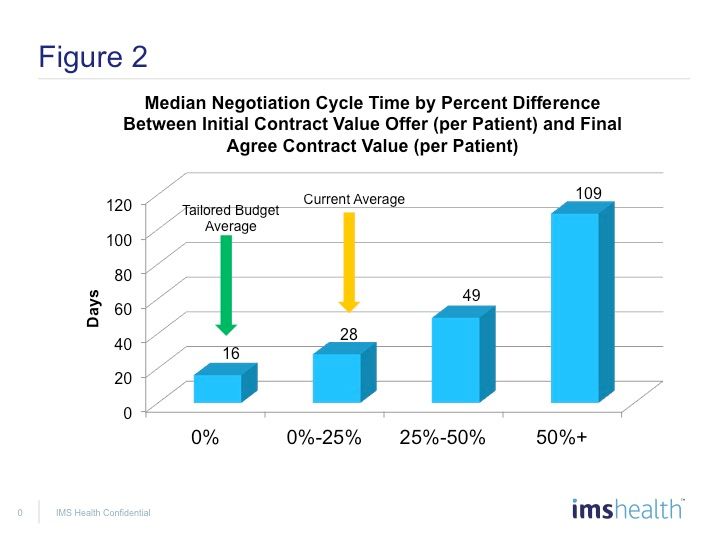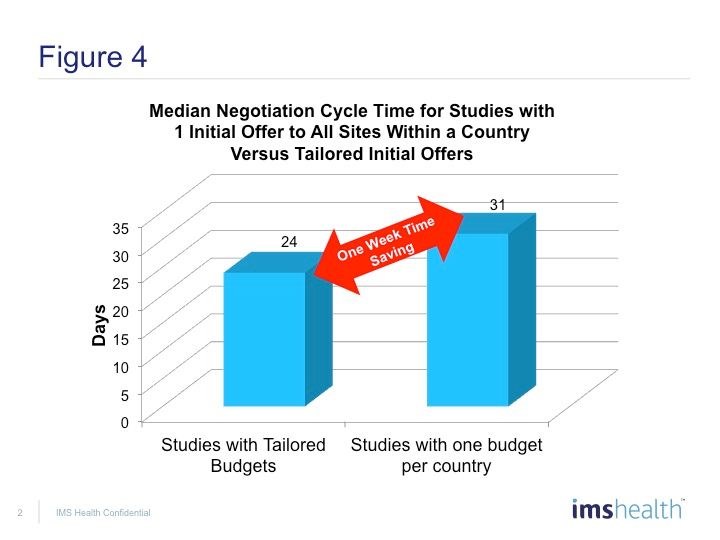Speeding Negotiations with Investigator Sites
The findings of analyzed data on clinical trial agreements (CTAs) stored in an online negotiation tool through which sponsors and investigators submit offers and counteroffers on clinical grant costs are shared in this article.
The Value of Tailored Grant Proposals
Every good negotiator understands that “success in negotiation is directly related to the amount and kind of preparation preceding the negotiations.1 Many leaders in clinical operations may not realize, though, just how much information is available to help them as they prepare grant proposals for investigator sites. Sponsors can, in fact, enter into negotiations with sites armed with great insight into what each site is likely to accept as payment for study participation. And, the closer sponsors are to hitting that mark with their initial offer, the shorter the negotiation cycle. IMS Health analyzed data on 16,240 grant offers and contracted budgets to understand the impact that tailoring the initial contract value has on the success and speed of the whole process.
The R&D pharmaceutical industry spends an estimated $12.3 billion each year in clinical trial grants to investigator sites, accounting for about 10% of all R&D spending. The negotiation process-the back and forth and give and take-with clinical trial sites before contracts are signed is one of the most unpredictable aspects of study start-up. Most sponsors aim to complete site negotiations with a given site in less than 20 days, but their ability to do so is quite varied. More than 23% of contract negotiations extend beyond 60 days. Also, the median length of the negotiation cycle is tied to the study phase, as shown in Figure 1. Typically, it takes 46 days to negotiate a Phase I study and 28 days for a Phase III study. Clearly, the more defined the protocol is, the less perceived risk there is in settling on prices and the less negotiation time is required to come to an agreement.2
Phase
Days
I
46
II
29
III
28
IV
19
Figure 1: Median Days of Negotiation Cycle Time by Study Phase
As research progresses, the protocol becomes increasingly established and there are fewer unknowns in the budgeting process, so negotiations are resolved more quickly.
About the study: An analysis of grant offers vs. contracted budgets
What other variables, aside from study phase, affect negotiation cycle time? Could the degree to which offers are tailored to the contract history of specific sites have an impact on negotiation timelines? How close can sponsors come to offering what sites will accept, and how much can that speed negotiations?
To answer these questions, we analyzed data on clinical trial agreements (CTAs) stored in an online negotiation tool through which sponsors and investigators submit offers and counteroffers on clinical grant costs. The data, extracted from our GrantPlan® database, included contract details on 16,240 clinical trials negotiated between September 1, 2010 and September 1, 2015. We compared the initial, time-stamped offer to the site with the final, time-stamped agreed-upon budget, and measured the time in between. Comparisons were made for per-patient treatment costs and one-time site costs such as electronic data capture (EDC) system training expenses, institutional review board (IRB) applications, and patient outreach to support recruitment.
Finding 1: Cycle time is tied directly to size of the value gap
How much price negotiation actually takes place between sponsors and sites before trial contracts are signed? On average, the final costs that are agreed upon between sponsors and sites are 8% higher than the original offer for per-patient costs and 17% for site costs. The difference by type of costs very likely reflects the fact that patient treatment costs are well established in the medical community, whereas there is naturally greater variability in the start-up and administrative costs that various sites incur in preparation for study participation.
The further away the initial offer is from what is finally agreed upon, the longer negotiations will take, both for per-patient costs and one-time site costs. While this conclusion might have been anticipated, it is worthwhile having empirical data to confirm that this as the case (see Figures 2 and 3). In fact, companies lose 1.4 days to negotiation for every percent that their initial offer is away from the final, agreed-upon amount.

When the final contract value for per-patient costs is 50% or more higher than that of the initial offer, the contract takes an average of 109 days to negotiate. That’s nearly four times longer than for offers that were within 25% of the final contract value.

When the final contract value for site costs is at least 50 percent higher than that of the initial offer, the contract takes an average of 60 days to negotiate. That’s close to three times longer than for offers that were within 25% of the final contract value.
Finding 2: Tailoring the initial offer can reduce negotiation time by a full week
Currently, more than half of the time (54%), sponsors approach all the sites in a given country with the same initial offer. In other words, they do not tailor their proposed rates by the type of site, much less the specific contracting history of each one.
Figure 4 illustrates how the negotiation timeline can be shortened by a full week when the initial budget offer is tailored to the individual site. These results are for per-patient and site costs, combined.

The median time required to negotiate contracts with sites can be shortened a full week-from from 31 days to 24 days-by tailoring the initial offer based on historical data on that site.
Finding 3: Negotiation cycle time is more sensitive to changes in per-patient costs than to changes in site costs
When the initial offer for reimbursed per-patient costs is tailored to the site’s history (and presumed expectation), the contracting process is shortened by 12 days over the current average of 28 days. The comparable reduction is six days with site costs.
Finding 4: Contracts are more likely to be signed when the initial offer is customized to the site
Negotiations conducted around tailored budgets failed to conclude in a contract 5% of the time, compared to 9% of the time for “boilerplate” offers extended to all sites within a country. That represents a 44% loss in opportunity. These findings, however, must be regarded with a caveat: companies are more likely to tailor their offers to sites with whom they’ve worked in the past because they have some historical experience on which they can draw. This also means that they have established a relationship with those sites, and the existence of that relationship might account for some of the success in closing the deals with this group.
How to tailor initial offers to sites
This research confirms that there is demonstrable value in opening negotiations with sites with payment proposals that are close to what the site expects and will ultimately agree to. The question then becomes, “How can a sponsor zero in on budget proposals that are appropriate for individual sites?”
The first step in the process is to maintain a repository of data on all contracts, by facility. These searchable details should include:
- The starting offer and date for patient treatment and site costs
- A history of the subsequent counteroffers and offers, with corresponding dates
- The names and positions of the individuals involved
When maintained at this level, a company’s own records will be quite helpful in dealing with familiar sites. However, this information should, ideally, be supplemented with benchmark data from a commercially available database that incorporates the results of others’ negotiations with sites across thousands of trials.
With such detailed information, it is possible to understand where different types of sites fall on the pay scale. On a broad level, for example, sponsors can understand the differences in how academic institutions vs. site management organizations negotiate. They can even get answers to more refined questions such as “What are the fees typically requested by sites that have five full-time equivalent staff members dedicated to research?”
The ultimate application of this information is to be able to know-prior to sending an offer-that a particular site, such as a university hospital, for example, typically settles for payment at the 80th percentile of the range. Knowing this is critical because the time difference between making an initial offer to this hospital in the 50th percentile vs. the 75th percentile could be weeks.
Conclusion
Sponsors can increase the predictability and speed of the contracting process with investigator sites by understanding each site’s past contracting history. When sponsors enter into negotiations armed with benchmark and historical information, they can make a more realistic initial offer that is closer to what the site will ultimately agree upon. In this way, sponsors can shave valuable time-one week on average-off of the contracting stage.
Lucas M. Glass is a data scientist within IMS Health’s Clinical Trial Optimization Solutions unit. He can be reached at lmglass@us.imshealth.com.
References
1. Gottlieb, M., and Healy, W. “Making Deals: The Business of Negotiating” (2nd ed.). Greenwich, CT: The Communication Project. (1998).
2. Glass, Lucas M. "Spotlight on Site Budget Negotiation Cycle Times.” Journal of Clinical Research Best Practices. Vol. 11, No. 11 (2015): p.1. First Clinical Research. Web. 15 Oct. 2015.
Behind the Buzz: Why Clinical Research Leaders Flock to SCOPE Summit
February 7th 2025In this episode, we meet with Micah Lieberman, Executive Conference Director for SCOPE Summit (Summit for Clinical Ops Executives) at Cambridge Innovation Institute. We will dive deep into the critical role of collaboration within the clinical research ecosystem. How do we bring together diverse stakeholders—sponsors, CROs, clinical trial tech innovators, suppliers, patients, sites, advocacy organizations, investors, and non-profits—to share best practices in trial design, program planning, innovation, and clinical operations? We’ll explore why it’s vital for thought leaders to step beyond their own organizations and learn from others, exchanging ideas that drive advancements in clinical research. Additionally, we’ll discuss the pivotal role of scientific conferences like SCOPE Summit in fostering these essential connections and collaborations, helping shape the future of clinical trials. Join us as we uncover how collective wisdom and cross-industry partnerships are transforming the landscape of clinical research.
Reaching Diverse Patient Populations With Personalized Treatment Methods
January 20th 2025Daejin Abidoye, head of solid tumors, oncology development, AbbVie, discusses a number of topics around diversity in clinical research including industry’s greatest challenges in reaching diverse patient populations, personalized treatment methods, recruitment strategies, and more.